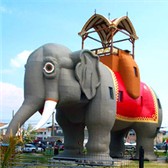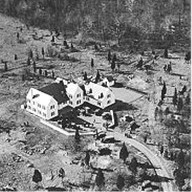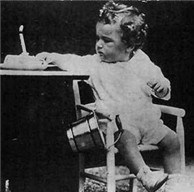Sorry for the delay in getting this second part posted — I still get my pictures developed the old-fashioned way!
No road trip of mine would be complete without stopping at the world’s largest something-or-other. Thus, those sites, along with some other quirky attractions, make up the second installment of “The Historic, the Fun, & the Popular.”
Stop 1: The World’s Largest Light Bulb is atop the Thomas Edison Memorial Tower in Menlo Park, N.J. (I suppose this could qualify for being historic, but anything with “world’s largest” in its name needs to be categorized as “fun.”) Menlo Park, of course, is the birthplace of the light bulb. The tower marks the spot where Edison’s workshop once stood; the workshop is now part of Henry Ford’s Greenfield Village in Dearborn, Mich. The light bulb itself is 13-feet tall and is illuminated at night.
Stop 2: In nearby Linden, there is a cemetary that houses a very unique tombstone. 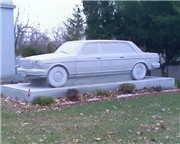 Yes, I know that cemetaries and tombstones probably shouldn’t fall under a “fun” category and I don’t mean any disrespect; you have to agree, however, that this is unique. The full-size 1982 Mercedes Benz limousine sadly marks the grave of 15-year-old who never got the car of his dreams in life. The 36-ton piece of granite is mind-boggling in its detail, down to the tire treads, grill work, and the boy’s name on the license plates.
Yes, I know that cemetaries and tombstones probably shouldn’t fall under a “fun” category and I don’t mean any disrespect; you have to agree, however, that this is unique. The full-size 1982 Mercedes Benz limousine sadly marks the grave of 15-year-old who never got the car of his dreams in life. The 36-ton piece of granite is mind-boggling in its detail, down to the tire treads, grill work, and the boy’s name on the license plates.
Stop 3: The World’s Largest Tooth is actually a 15-tall sculpture that sits along a main thoroughfare in Hutchinson Mill, N.J. See my Nov. 26 post for a photo.
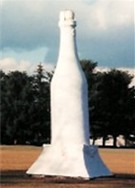
Stop 4: Tuckerton, N.J., is home to one of several 20-foot high champagne bottles in the area built by the Renault Winery in the 1920s. This one is white stone. Another one is located further north in Bayville, N.J., but I couldn’t find that one (although how one can miss a tall champagne bottle I’m not sure).
Stop 5: I didn’t really stop in Atlantic City, N.J., just drove through it, but it’s worth a mention because I felt like I was on a giant Monopoly board. It was nostalgic as well because, long before the casinos came into town, my family spent our summers there when I was growing up.
Stop 6: Just south of Atlantic City was my final stop — a place I had wanted to see for many years and, in fact, was the whole reason I was on the New Jersey shore — Lucy the Elephant. Lucy is the trademark of Margate City; she even appears on the town’s water tower. Open up ANY roadside attraction book and you will see Lucy gracing a page. Now 127 years old, Lucy is in great shape, thanks to local renovation efforts and is designated as a National Historic Landmark. Lucy is six stories high, weighs 90 tons, and is covered in 12,000 square feet of tin.
Filed under: Historic Attractions, roadside attractions, Travel, world's largest | Tagged: Big Champagne Bottles, Lucy the Elephant, Menlo Park, Mercedes Benz tombstone, Thomas Edison, Thomas Edison Memorial Tower, world's largest light bulb, world's largest tooth | 3 Comments »




